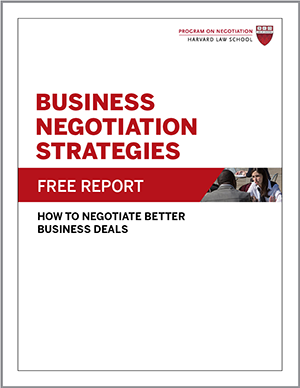
Suppose that two entrepreneurs, a marketing expert and an IT specialist, are thinking about merging their consulting firms to create a greater synergy of services. As their talks unfold, each wonders how much information to disclose at the negotiation table. Should they bring up discussions with other potential partners? When should they share proprietary business data? What if one is planning to retire in two years, and the other is starting a family—should they share this personal information? Fearful of being hurt by revealing too much information, most negotiators play their facts and preferences close to the vest. At the other end of the spectrum, the current negotiation theory advises us to cooperate whenever possible, revealing information to create maximum value.
Yet the question of when to reveal information in negotiation is seldom clear-cut. Whether relying on traditional assumptions about competing for scarce resources or on newer ideas about realizing a joint gain, wise negotiators pause to consider the possible benefits and costs of revealing or concealing information. They also recognize that different types of information—ranging from facts to opinions to preferences—exist in any negotiation and that the importance of this data may fluctuate as the process unfolds.
Before talks begin at the negotiation table—and, if possible, even before your initial contact with your counterpart—list the information you need to resolve your dispute or to build a strong deal. Also, anticipate the information the other side will want from you, and consider how you’ll respond to these queries. Information typically falls into these categories:
• Facts: Information about relevant past events, goods, and services; ongoing obligations and liabilities; parties needed to conclude talks; and so forth.
• Opinions, values, and predictions: Information subject to different interpretations, such as a company’s value, the likely income from a new product, the outcome of a future court decision, or whether the dollar will rise or fall.
• Preferences: Information that negotiators express as their needs, interests, goals, objectives, desires, bottom lines, and reservation prices.
Once you have identified the information you need and may be asked to reveal, you’re ready to consider the reasons you and your counterpart might choose to disclose or conceal it.
Set an appropriate trust default for the negotiation table
It would be a mistake to assume that if you’ve vetted your negotiating partner and spent time getting to know each other that you can trust him implicitly.
Negotiators often make the mistake of assuming a fully trusting relationship with the other party. When things go wrong, they are left feeling shocked, hurt, and perhaps lighter in the wallet. Keep in mind that negotiators can feel trust has been broken even when neither side has behaved with deliberate deception.
Conflicts of interest, the common tendency to overclaim credit for one’s contributions, and other widespread cognitive biases can lead us to view the same events differently and jump to the false conclusion that trust has been irreparably broken.
One way to reduce the odds of trust betrayal is to change the “trust default” that negotiators hold when talks begin, recommend Harvard Kennedy School professor Iris Bohnet and Stephan Meier, senior economist at the Federal Reserve Bank of Boston.
As substantive talks begin, take time to discuss ground rules, including your basic beliefs about trust. Explain that you are a conservative risk taker who would like to build trust slowly, over time.
For example, Carol, the patient in our opening vignette, might have told her doctor during her first checkup that she values second opinions and intends to seek them out when appropriate.
By establishing a cautious approach to trust from the start—and keeping your files of correspondence and key documents up to date—you may be able to avoid contention when difficulties arise at the negotiation table.
Have you ever revealed too much at the negotiation table? How did it impact your outcome? Leave us a comment.
Adapted from “Know When to Show Your Hand,” by Carrie Menkel-Meadow (professor, Georgetown University Law Center), first published in the Negotiation newsletter.





